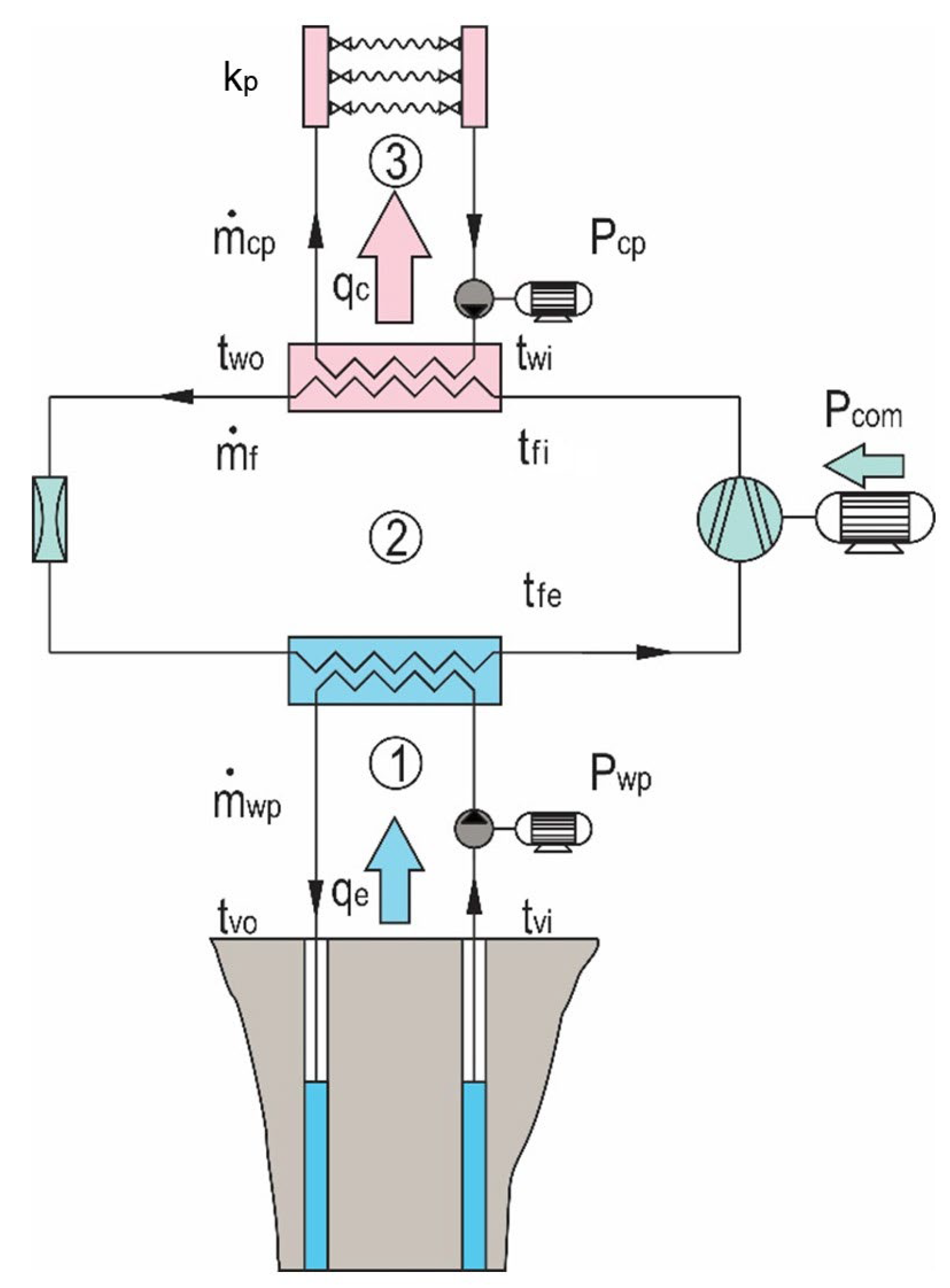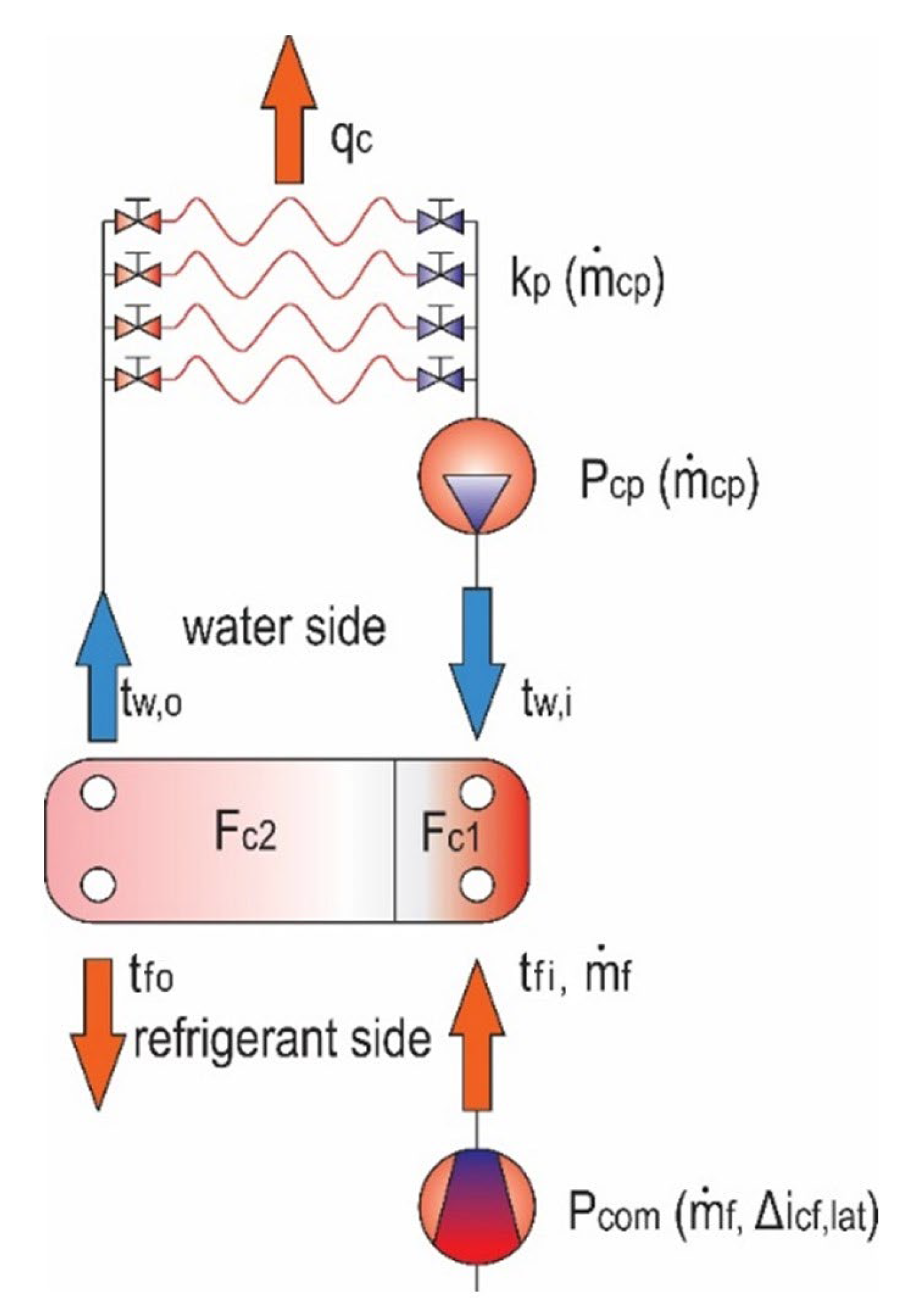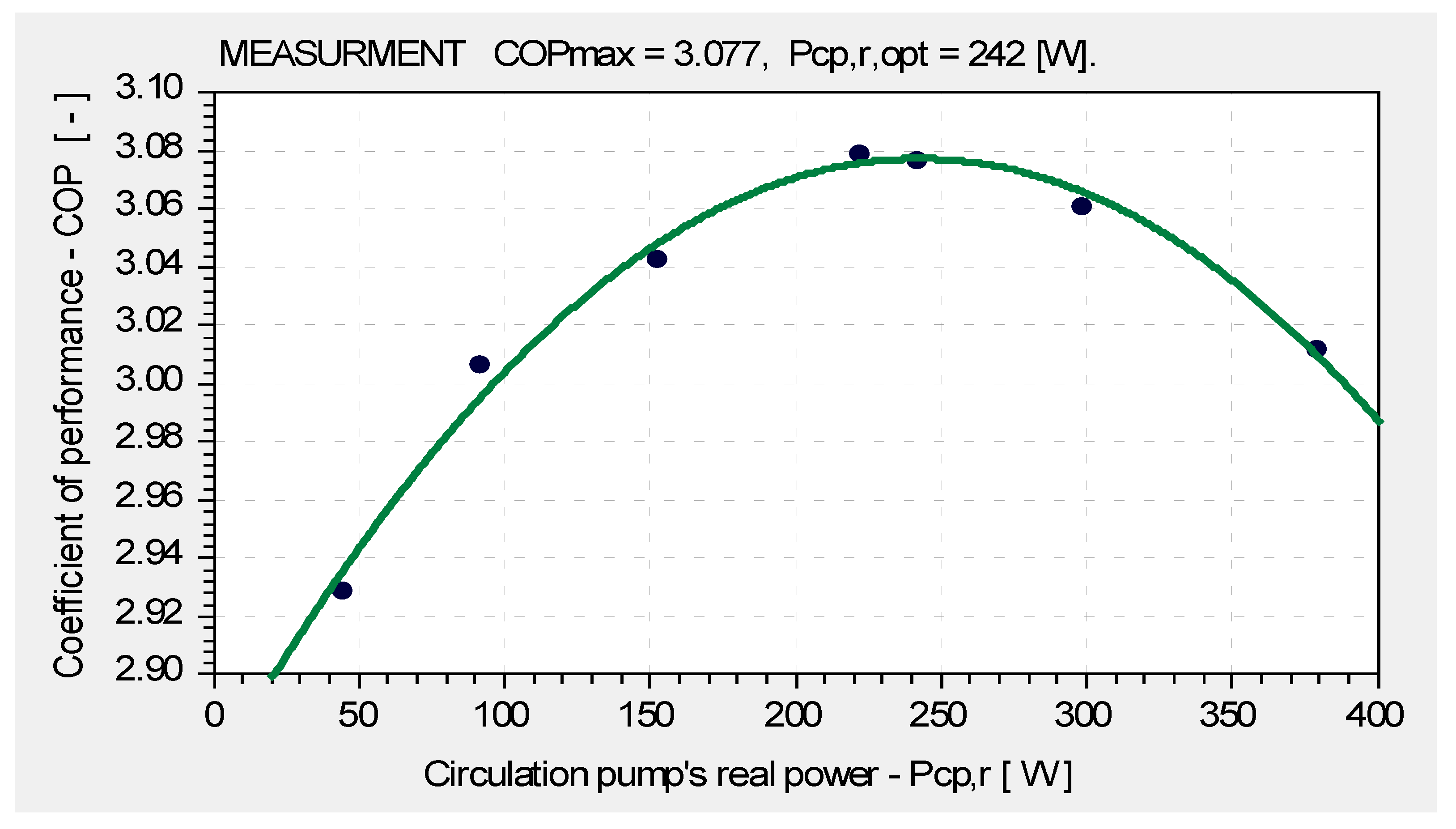Enhancing the Energy Efficiency—COP of the Heat Pump Heating System by Energy Optimization and a Case Study
Abstract
:1. Introduction
2. Physical System
3. Mathematical Methods
3.1. Description of the Method
3.2. Objective Functions of the Heating System—
3.3. Local Energy Optimum as a Function of the Circulation Pump Power
3.4. Local Energy Optimum as a Function of the Well Pump Power
3.5. The Local Energy Optimum Condition after the Derivation Is as Follows
3.6. The Global Multi Objective Energy Optimum
4. Case Study
4.1. Physical Model of the Warm Water Loop
4.2. Basic Mathematical Model of the Condenser
4.2.1. Governing Equations of the Condenser
4.2.2. Auxiliary Equations
4.3. Modified Mathematical Model of the Condenser
4.4. Mathematical Model of the Circulation Pump
4.5. Mathematical Model of the Compressor
4.6. Optimizer Model of the Warm Water Loop
4.6.1. Heat Flow Derivatives of the Condenser
4.6.2. Partial Derivative of the Circulation Pump Effective Power
4.6.3. Partial Derivative of the Circulation Pump Efficiency
5. Numerical Procedure
The Maximum of the Heat Pump Heating System
6. Measurements and Measuring System
- Refrigerant vapor temperature at the input of the compressor ,
- Warm water temperature at the input of the condenser ,
- Series of adjusted pressure heads of the circulation pump ,
- The real powers of c. pump ,
- Well pump real power .
| 47.3 | 45.2 | 44.2 | 43.7 | 43 | 42.85 | |
| 40 | 40 | 40 | 40 | 40 | 40 | |
| 0.455 | 0.657 | 0.826 | 0.947 | 1.168 | 1.21 | |
| 13,889 | 14,302 | 14,526 | 14,673 | 14,587 | 14,678 | |
| 2 | 4 | 6 | 8 | 10 | 12 | |
| 19,620 | 39,240 | 58,860 | 78,480 | 98,100 | 117,720 | |
| 44 | 91 | 152 | 222 | 298 | 379 | |
| 8.93 | 25.78 | 48.6 | 74.32 | 107.13 | 142.44 | |
| 0.203 | 0.283 | 0.326 | 0.334 | 0.359 | 0.376 | |
| 4192 | 4128 | 4116 | 4044 | 4028 | 3984 | |
| 0.83 | 0.84 | 0.85 | 0.865 | 0.867 | 0.87 | |
| 505 | 505 | 505 | 505 | 505 | 505 | |
| 2.939 | 3.010 | 3.035 | 3.059 | 3.066 | 3.019 |
6.1. Measuring System
- Glass-tube alcohol thermometers, 0.1 °C accuracy, range 0–100 °C,
- Insa type water volumetric flow meter with a ±2% accuracy, range 0–100 m3,
- Refco type manometers with a ±2% accuracy, range 0–30 bar for measuring the different pressure produced by the circulation pump,
- Voltage and ampere meter for measuring the power of the compressor and well pump, ±1% accuracy, range 0–600 V, 0–20 A,
- Stopwatch to determine the water volumetric flow rate, digital.
6.2. Physical System
- Heat pump (Tera Term, Co.) with a scroll compressor with a nominal power of 4000 W and plate heat exchangers with nominal 2 m2, i.e., 1.6 m2 effective surface,
- Circulation pump (Wilo, Dortmund, Germany) with a nominal power of 400 W and frequency-control that enables the control of differential pressure, power, and number of revolutions.

6.3. Measurement Process
7. Results and Discussion
8. Conclusions
- The analytical part of the energy optimization procedure provides a linked insight into the interaction between mathematics and the physical system. The numerical part of the procedure provides accurate results for the local and global multi objective optimum power of the pumps,
- The advantage of the procedure is, by varying the temperature of the input warm water, it is possible to determine the optimal power of the circulation pump and the maximum in each operation point,
- The accuracy of the energy optimization procedure was proven through measurements. The difference in the maximum is 0.6% and 1.5% in the optimal power of the circulation pump, only. Table 2,
- The algorithm presents the complete mathematical method of the procedure with the type and number of variables,
- The values obtained by the procedure presented in tables and graphs provide an important guide for practice. The evaluation with numbers and data can be found in the points below,
- The efficiency of the circulation pump has a significant impact on the , since its values are small, varying between 0.203 and 0.376 despite the fact that the real power is 242 [W] only,
- The compressor efficiency is significantly better and varies in the narrower range of 0.83–0.87 (measured), but its power is 4050 [W], so the influence of the compressor’s efficiency on the is also significant,
- The simulation value of the maximum without the efficiency of the compressor and circulation pump is . With the efficiencies, based on the measurements, its value is only or the analytically-numerically optimized value is In percentages, the has times higher value, as calculated without efficiencies,
- The parabolic graph (Figure 5) is smooth and flat, the difference is only , so the effect of the power of the circulation pump on the is weak. Although, the increment of the real power of the circulation pump is relatively large 44 − 379 = 335 W, the rate of change is 379:44 = 8.6, (860%),
- Since the graph is flat, reducing the power of the pump only slightly reduces the value. So, a pump of 100 W that has less than the optimal power of 242 W, reduces the by only 1.2%. Therefore, it is reasonable to carry out the multi objective optimization using the economic and energy objectives,
- At the optimum point, the measured and optimized value of the circulation pump is 242 W and 238.5 W, while the compressor power is 4050 W. The power ratio is 4050:242 = 16.7. Therefore, the dominance of the compressor power on the is significantly larger, in proportion to the ratio of the powers,
- By optimizing the power of the circulation pump, the value increases approximately, i.e., . However, by optimizing the power of the circulation and well pumps globally, the increase will be significantly greater.
Author Contributions
Funding
Data Availability Statement
Conflicts of Interest
Abbreviations
| Symbol | Meaning | Dimension |
| ṁ | Mass flow rate [kg/s] | |
| k | Overall heat transfer coefficient | [W/m2/K] |
| Cp | Specific heat, p = const. | [J/kg/K] |
| t | Temperature | [°C], [K] |
| Δt | Temperature difference | [°C], [K] |
| Δp | Pressure drop | [N/m2] |
| p | Pressure | [N/m2] |
| F | Heat transfer surface | [m2] |
| Ad | Cross section area | [m2] |
| Δi | Latent heat | [J/kg] |
| i | Specific enthalpy | [J/kg] |
| P | Performance or power | [W] |
| q | Heat flow | [W] |
| kp | Coefficient of hydraulic resistance of pipeline in warm water loop | [Ws3/kg3] |
| Convective heat transfer coefficient | [W/m2/K] | |
| Coefficient of performance | [-] | |
| Efficiency of pump and compressor | [-] | |
| Length of pipe | [m] | |
| Diameter of pipe | [m] | |
| Coefficient of hydraulic friction | [-] | |
| Relative roughness of pipe | [-] | |
| Re | Reynolds number | [-] |
| ρ | Density | [kg/m3] |
| Subscripts and Superscripts | ||
| w | Water | |
| f | Refrigerant | |
| i | Input | |
| o | Output | |
| e | Evaporator | |
| c | Condenser | |
| com | Compressor | |
| cp | Circulation pump | |
| wp | Well pump | |
| la | Latent | |
| opt | Optimum | |
| ln | Logarithm natural | |
| e | Effective | |
| r | Real | |
| 1 | Vapor cooler section | |
| 2 | Vapor condensation section | |
Appendix A
Specific Heat of Refrigerant R134a
References
- Jensen, B.J.; Skogestad, S. Degrees of freedom and optimality of sub-cooling. Comput. Chem. Eng. 2007, 31, 712–721. [Google Scholar] [CrossRef]
- Olympios, V.A.; Sapin, P.; Freeman, J.; Olkis, C.; Markides, N.C. Operational optimisation of an air-source heat pump system with thermal energy storage for domestic applications. Energy Convers. Manag. 2022, 273, 116426. [Google Scholar] [CrossRef]
- Ma, R.; Qiao, H.; Yu, X.; Yang, B.; Yang, H. Thermo-economic analysis and multi-objective optimization of a reversible heat pump-organic Rankine cycle power system for energy storage. Appl. Therm. Eng. 2022, 220, 119658. [Google Scholar] [CrossRef]
- Atasoy, E.; Çetin, B.; Bayer, O. Experiment-based optimization of an energy-efficient heat pump integrated water heater for household appliances. Energy 2022, 245, 123308. [Google Scholar] [CrossRef]
- Zhou, K.; Mao, J.; Li, Y.; Zhang, H. Performance assessment and techno-economic optimization of ground source heat pump for residential heating and cooling: A case study of Nanjing, China. Sustain. Energy Technol. Assess. 2020, 40, 100782. [Google Scholar] [CrossRef]
- Krützfeldt, H.; Vering, C.; Mehrfeld, P.; Müller, D. MILP design optimization of heat pump systems in German residential buildings. Energy Build. 2021, 249, 111204. [Google Scholar] [CrossRef]
- Hosseinnia, M.S.; Sorin, M. Techno-economic approach for optimum solar assisted ground source heat pump integration in buildings. Energy Convers. Manag. 2022, 267, 115947. [Google Scholar] [CrossRef]
- Delač, B.; Pavković, B.; Grozdek, M.; Bezić, L. Cost Optimal Renewable Electricity-Based HVAC System: Application of Air to Water or Water to Water Heat Pump. Energies 2022, 15, 1658. [Google Scholar] [CrossRef]
- Nordgård-Hansen, E.; Kishor, N.; Midttømme, K.; Risinggård, V.R.; Kocbach, J. Case study on optimal design and operation of detached house energy system: Solar, battery, and ground source heat pump. Appl. Energy 2022, 308, 118370. [Google Scholar] [CrossRef]
- Halilovic, S.; Böttcher, F.; Kramer, C.S.; Piggott, D.M.; Zosseder, K.; Hamacher, T. Well layout optimization for groundwater heat pump systems using the adjoint approach. Energy Convers. Manag. 2022, 268, 116033. [Google Scholar] [CrossRef]
- Santa, R.; Garbai, L.; Fürstner, I. Optimization of heat pump system. Energy 2015, 89, 45–54. [Google Scholar] [CrossRef]
- Granryd, E. Analytical expressions for optimum flow rates in evaporators and condensers of heat pumping systems. Int. J. Refrig. 2010, 33, 1211–1220. [Google Scholar] [CrossRef]
- Edwards, K.C.; Finn, D.P. Generalized water flow rate control strategy for optimal part load operation of ground source heat pump systems. Appl. Energy 2015, 150, 50–60. [Google Scholar] [CrossRef]
- Nyers, A. Víz-Víz Hőszivattyús Fűtési Rendszerek Energetikai Optimizálása. Ph.D. Thesis, Gépészmérnöki Kar, BMGE, Budapest, Hungary, 2016. Available online: https://repozitorium.omikk.bme.hu/bitstream/handle/10890/5352/tezis_hun.pdf?sequence=3&isAllowed=y (accessed on 3 March 2019).
- Nyers, J.; Nyers, A. Investigation of Heat Pump Condenser Performance in Heating Process of Buildings using a Steady-State Mathematical Model. Int. J. Energy Build. 2014, 75, 523–530. [Google Scholar] [CrossRef]
- Nyers, J. An analytical method for defining the pump’s power optimum of a water-to-water heat pump heating system using COP. Therm. Sci. 2017, 21, 1999–2010. [Google Scholar] [CrossRef]
- Eordoghne Miklos, M. Investigation of energy efficiency of pumping systems by a newly specified energy parameter. In Proceedings of the 11th International Symposium on Exploitation of Renewable Energy sources and Efficiency, EXPRES 2019, Subotica, Serbia, 11–13 April 2019; pp. 21–25, ISBN 978-86-919769-4-1. [Google Scholar]
- MATLAB Programming and Numeric Computing Platform. Available online: https://www.mathworks.com/products/matlab.html (accessed on 21 May 2020).
- Jokar, A.; Hosni, H.; Mohammad, J.; Eckels, S. Dimensional analysis on the evaporation and condensation of refrigerant R-134a in mini channel plate heat exchangers. Appl. Therm. Eng. 2006, 26, 2287–2300. [Google Scholar] [CrossRef]
- Ko, Y.M.; Jung, J.H.; Sohn, S.; Song, C.H.; Kang, Y.T. Condensation heat transfer performance and integrated correlations of low GWP refrigerants in plate heat exchangers. Int. J. Heat Mass Transf. 2021, 177, 121519. [Google Scholar] [CrossRef]
- Expert Curve Software Package. Available online: https://www.curveexpert.net/ (accessed on 25 September 2019).
- Astina, M.I.; Sato, H. A fundamental equation of state for 1,1,1,2-tetrafluoroethane with an intermolecular potential energy background and reliable ideal-gas properties. Fluid Phase Equilibria 2004, 221, 103–111. [Google Scholar] [CrossRef]





| Analytical optimization | 3.096 | 238.5 |
| Measurements | 3.077 | 242 |
| Difference | 0.019/3.077 = 0.006 0.6% | 3.5/238.5 = 0.015 1.5% |
Disclaimer/Publisher’s Note: The statements, opinions and data contained in all publications are solely those of the individual author(s) and contributor(s) and not of MDPI and/or the editor(s). MDPI and/or the editor(s) disclaim responsibility for any injury to people or property resulting from any ideas, methods, instructions or products referred to in the content. |
© 2023 by the authors. Licensee MDPI, Basel, Switzerland. This article is an open access article distributed under the terms and conditions of the Creative Commons Attribution (CC BY) license (https://creativecommons.org/licenses/by/4.0/).
Share and Cite
Nyers, A.; Nyers, J. Enhancing the Energy Efficiency—COP of the Heat Pump Heating System by Energy Optimization and a Case Study. Energies 2023, 16, 2981. https://doi.org/10.3390/en16072981
Nyers A, Nyers J. Enhancing the Energy Efficiency—COP of the Heat Pump Heating System by Energy Optimization and a Case Study. Energies. 2023; 16(7):2981. https://doi.org/10.3390/en16072981
Chicago/Turabian StyleNyers, Arpad, and Jozsef Nyers. 2023. "Enhancing the Energy Efficiency—COP of the Heat Pump Heating System by Energy Optimization and a Case Study" Energies 16, no. 7: 2981. https://doi.org/10.3390/en16072981
APA StyleNyers, A., & Nyers, J. (2023). Enhancing the Energy Efficiency—COP of the Heat Pump Heating System by Energy Optimization and a Case Study. Energies, 16(7), 2981. https://doi.org/10.3390/en16072981






